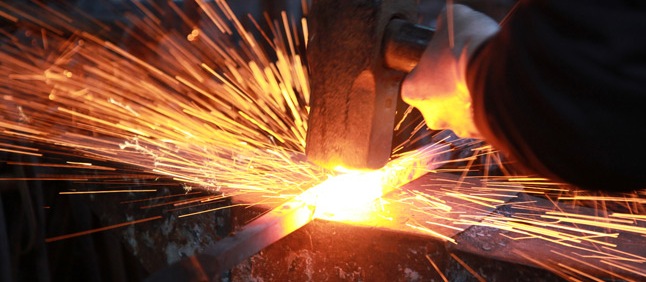
The Forging of the Sword Mimung
by Peter Krüger
©2013
[Germanic Astronomy]
In Thidrekssaga af Bern, the smiths Velent and Amilias, compete to see which is the better smith. Both are given twelve months to forge their arms. In ‘Germanic Variants of the Scorpio and Orion myth’, I have previously explained the competition between the smiths Velent and Amilias as a description of the rising of the stinger of the constellation Scorpio (= the sword Mimung) causing the setting of the constellations Taurus (= the helmet of Amilias) and Orion (the suit of armor of Amilias).
The forging of Mimung by Velent is accompanied by some strange circumstances that require explanation. In contrast to Amilias who immediately begins work on his craft, Velent doesn't start to work on his for the first six months. Asked by king Nidung for the reason, Velent confesses that he can not find where he had buried his tools. He thus assumes that they have been stolen by a man, whom he had seen, but whose name he does not know. In order to identify the stranger, King Nidung orders an assembly of all men in his kingdom, but Velent fails to recognize the thief. Later on, Velent fashions a human figure in the image of the man who had stolen his tools. At the sight of the figure, the king identifies him as his servant Regin who is abroad. Nidung orders him back and Regin returns the tools to Velent. However, it takes four more months for Velent to start his work.
At last, pressed by the king, he manufactures, in a week's time, a sword which the king much admires. They go with this weapon to the banks of a river. Velent sends a piece of wood a foot thick floating down with the current, and holds his sword before it; the wood, pushed by the current against the edge of this weapon, is cut in two. On his return home, the artisan breaks his sword in pieces, melts it down, and in three days manufactures another. Again, accompanied by the king, he goes to the river's edge. In the same manner, he tests the sword against another piece of wood, now two feet in thickness. Again, the wood is cut in two. And again, Völund breaks down the blade, as not sufficient, and in three hours makes a third, encrusted with gold, which he successfully tests as before, but this time with a piece of wood three feet square. The king is charmed with this sword, and declares that he will never have any other.
The story above contains some unusual details that raise several questions:
Why can Velent forge the sword only with his special tools?
What is the meaning of the human figure fashioned by Velent?
And is there a reason behind the timeframes given?
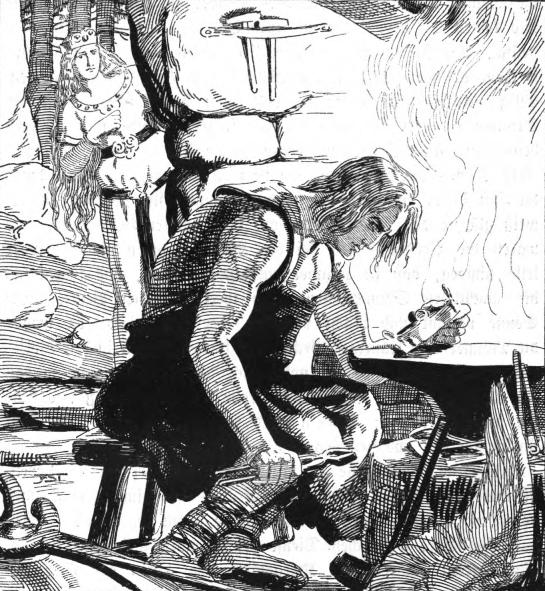 |
There is another story, preserved in Skáldskaparmál in which a smith's tool, the tongs, play a major role. It is the fight between Thor and Geirrödr. Previously, I explained that myth with the rising of the Pleiades and Taurus causing the setting of Boötes.
"Then Geirrödr had Thor called into the hall to play games. There were great fires the whole length of the hall. When Thor came up over against Geirrödr, then Geirrödr took up a glowing bar of iron with the tongs and cast it at Thor. Thor caught it with his iron gloves and raised the bar in the air, but Geirrödr leapt behind an iron pillar to save himself. Thor lifted up the bar and threw it, and it passed through the pillar and through Geirrödr and through the wall, and so on out, even into the earth.”Geirrödr takes up a glowing bar of iron with tongs. What can this refer to? The mightiest tongs in heaven are surely the huge claws of the constellation Scorpion (later changed into the modern constellation of Libra the Scales). In Sumerian times, the claws were already seen as a seperate part of the whole of Scorpion. In German, the most common word for the claws of a scorpion is scheren but the word zangen ('tongs') is also used.
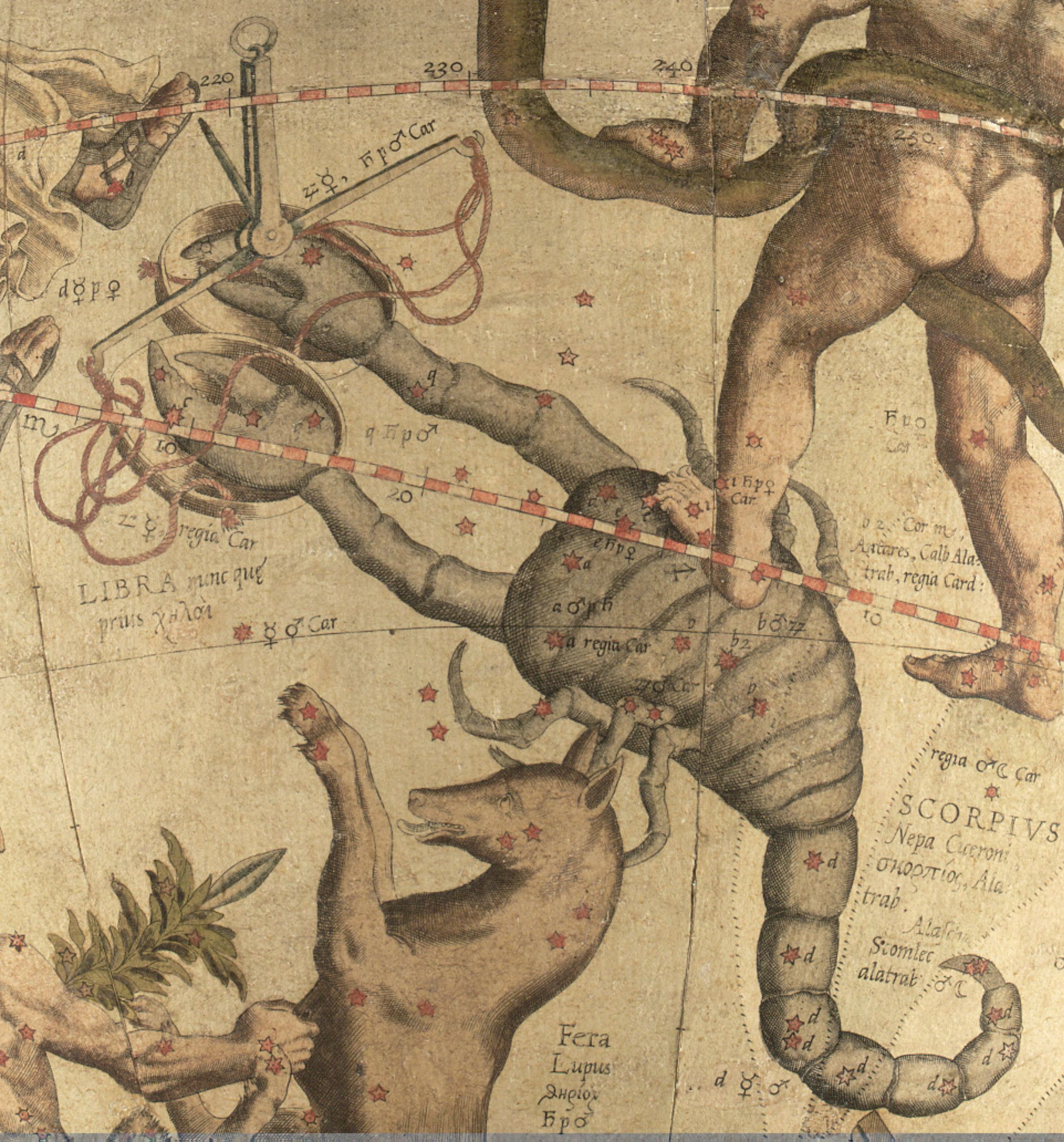 |
Another part of the constellation Scorpio is its breast, formed by the bright red super-giant called Antares. In cuneiform, it contains the element LI9, representing a brazier. Here this bright red star might be a glowing piece of iron used by Velent to forge the sword.
There is another very interesting accordance: The body of Scorpio seems to appear in some contexts as a river. For example, I equated the river Sliðr mentioned in Völuspá 36 with the body of Scorpio cutting through the Milky Way, and surely it is not coincidence that it refers to swords and daggers:
|
“Á fellur austan |
“From the east there pours through poisoned vales With swords and daggers the river Slith.” |
In summary, in the tale of the forging of Mimung, we find references to all parts of the constellation Scorpio: the claws of the scorpion form the tongs; Antares may be a piece of hot iron; the body of the scorpion is seen as a winding river; and its stinger as the sword Mimung.
"Below the fiery sting of the dread monster, Scorpion, and near the South is hung the Altar [Ara]."
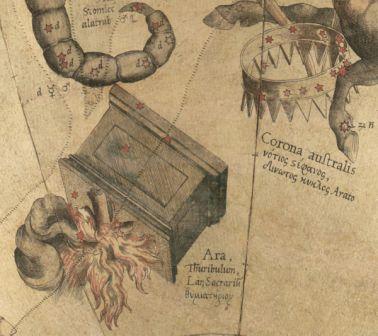 |
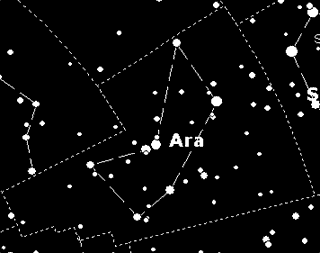 |